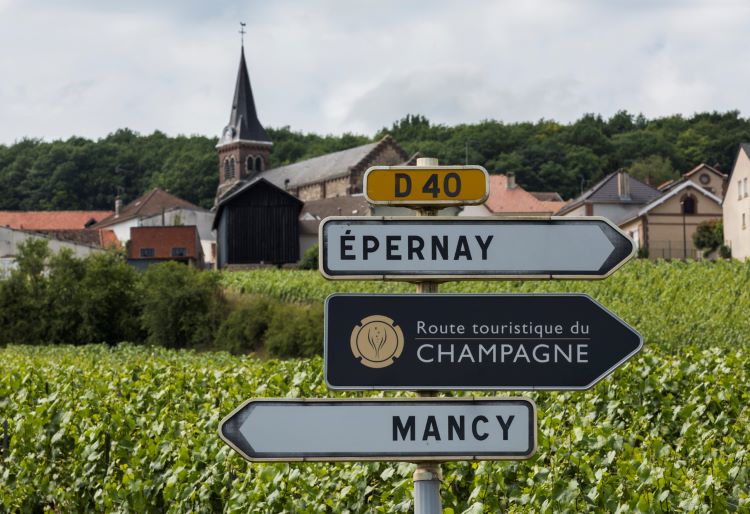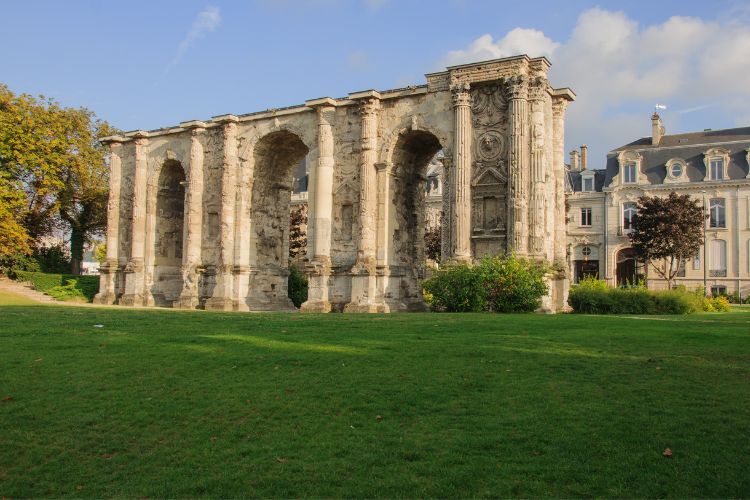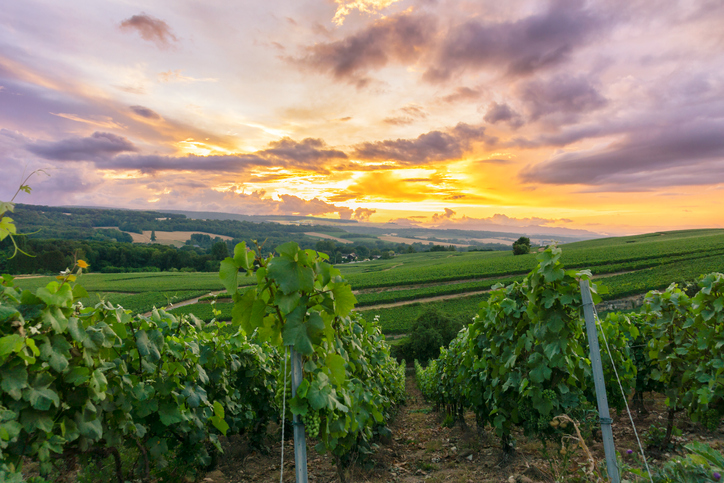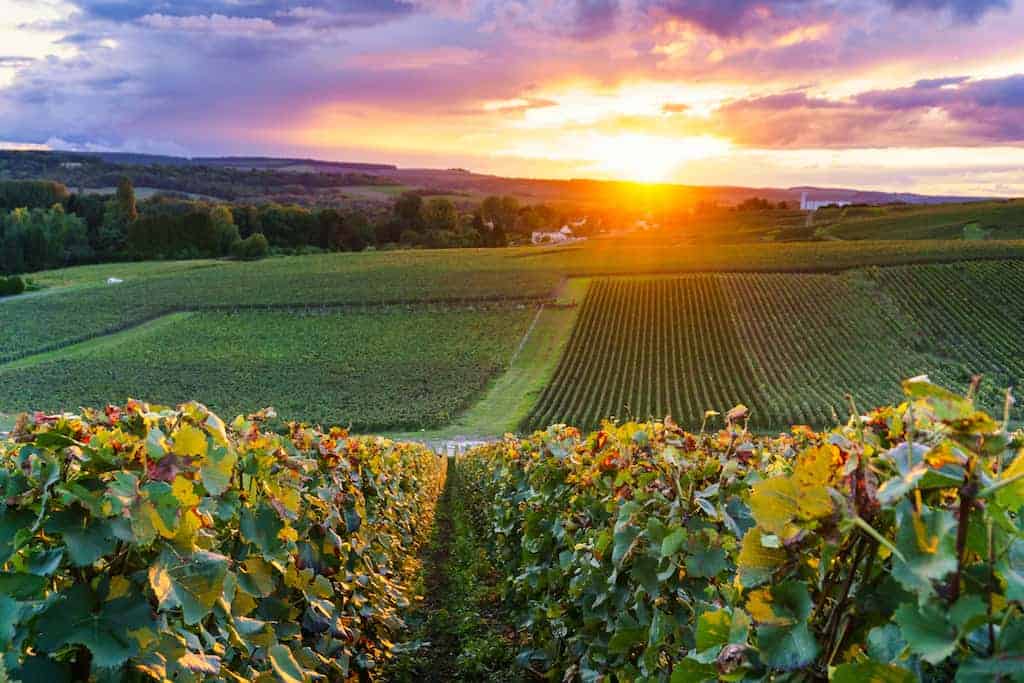Guide to Visiting Champagne France
A visit to the Champagne region of France is quite different compared to visiting any other wine region across the globe. Located northeast of Paris, this small region produces what may be considered the most renowned and recognizable wine in the world.
While the region may be small, there is plenty to do and see, and of course, lots of bubbles to sip along the way! This straightforward travel guide is designed to highlight some of the best things to do in Champagne in addition to some of the best vineyards to visit.
- Guide to Visiting Champagne France
- Champagne Region Basics
- Champagne Tour Options
- What To See in Champagne France
- Where to Stay in Champagne
- Understanding Champagne as a Wine
- Best Wine Bars, Cafes, & Restaurants in Champagne
- Best Vineyards in Champagne France to Visit
- Frequently Asked Questions about Visiting Champagne France

Champagne Region Basics
First, check flight prices directly into Paris. The easiest way to get to Champagne is by either car or by rail. There are direct express trains (TGV) running multiple times daily from Paris to Reims, the capital of the Champagne. The train ride will take you approximately 45 minutes.
RELATED: 45 Best Things to Do in Paris This Year
There is also a train route available that takes you to the second city of the Champagne — Epernay. Getting to Epernay by train will take a little bit longer, closer to an hour and a half. That being said, whichever destination you choose to begin your journey should be based on the kind of experience you’re looking to have in Champagne.
Reims is a wonderful town to walk around, with many Champagne retailers, restaurants, and tasting rooms. If you’re looking to visit the producers themselves, or visit Epernay, we suggest renting a car as having the flexibility will make your trip much more enjoyable.
Tickets for the TGV can be purchased online in advance or at the station, and there are several departures throughout the day. Travelers can also choose from a range of seating options, including standard, first class, and premium classes.
RELATED: 2 Day Planned Itinerary for Visiting the Champagne Region of France
Champagne Tour Options
Once in Champagne, there are many premium, private tour options available to visitors. While we have several favorites, À La Française offers a great full-day option that includes hotel pickup and drop-off in Reims or Epernay. It’s ideal for both first time visitors and experienced Winetraveler’s who are looking to get a fresh taste and local’s perspective. If you’re looking for a backup tour option, the same company offers a Grower’s tour (for serious sparkling wine enthusiasts), including a stop at Champagne House Boizel and their underground cellars. The tour also provides a lovely lunch at Le Clos Corbier.
By the way, if you’re planning on spending an extended amount of time in Paris or simply looking to get your palate wet, we recommend visiting and having a guided experience at O Chateau inside their wine cellar in Paris for tastings and pairings. You’ll get to sample and understand Champagne before visiting, in addition to some of France’s other acclaimed wine regions and classic cuisine offerings.
What To See in Champagne France
Cathedrale Notre-Dame de Reims (Reims)

The Cathedrale Notre-Dame de Reims is an architectural masterpiece located in the heart of Champagne. The cathedral is one of the most iconic and significant buildings in the region, and a must-visit destination for anyone traveling to the area.
Constructed in the 13th century, it’s a stunning example of Gothic architecture, featuring intricate carvings, towering spires, and breathtaking stained glass windows. The interior is equally impressive, with vaulted ceilings, ornate decorations, and a peaceful atmosphere that inspires contemplation and reflection.
The cathedral holds a special place in French history and culture, as it was the site of coronations for many of France’s monarchs, including Charles VII and Louis XVI. Today, visitors can admire the impressive architecture, explore the rich history and artistry, and experience the spiritual significance of this remarkable building.
Palais du Tau (Reims)
This majestic building located in the heart of Reims. Once the residence of the archbishop of Reims, the Palais du Tau is now a museum that houses some of the most important artifacts from Champagne’s rich history. The building itself is a stunning example of medieval architecture, featuring a mix of Gothic and Renaissance styles that showcase the opulence and grandeur of the French monarchy. The palace is home to a vast collection of treasures, including tapestries, sculptures, and ceremonial objects, that tell the story of the region’s rich cultural heritage.
One of the most impressive features of the Palais du Tau is its ornate façade, which features intricate carvings and sculptures that depict scenes from the Bible and the lives of saints. Inside, visitors can admire the stunning architecture, explore the museum’s impressive collection, and learn about the fascinating history of the palace and the region it represents.
Porte Mars (Reims)
Porte Mars was built in the 3rd century AD and served as a monumental gateway to the city from the Roman road that connected Reims to other important cities in the region. The arch is made of stone and stands at an impressive 33 meters (108 feet) tall, with three arches and intricate carvings and decorations. Despite its age, the arch is well-preserved and has been carefully restored over the centuries.
Today, Porte Mars is a popular attraction and is considered one of the most significant Roman landmarks in France. The arch’s impressive size and details, which include depictions of Roman gods and goddesses, battles scenes, and other decorative elements, will not soon be forgotten. The arch is also located in a picturesque park, making it a perfect spot for a leisurely stroll or a picnic with a bottle of Champagne. Audio tours and even games for exploring the area on your phone are now bookable in advance.
Avenue de Champagne (Epernay)
A drive down this avenue will quickly acquaint you with many of the famed producers of Champagne. Unseen at street-level, there are hundreds of miles of caves, which house over 200 million bottles slowly aging over time, just beneath your feet.
Abbey of Hautvillers (Ay, FR)
Located on the edge of the Reims Mountain Nature Reserve, the Abbey of Hautvillers is a stunning historic monastery. This beautiful abbey is best known for being the birthplace of Champagne, where the monk Dom Perignon is said to have perfected the production method of this famous sparkling wine. The abbey itself is a stunning example of French Gothic architecture, featuring a beautiful church, tranquil cloisters, and impressive buildings and gardens. Visitors can explore the abbey’s rich history and learn about the life of the monk who called it home.
One of the highlights of a visit to the Abbey of Hautvillers is the opportunity to sample some of the world’s finest champagnes produced by the many wineries in the area. The surrounding vineyards and countryside provide a stunning backdrop for a leisurely stroll or bike ride, while the picturesque town of Hautvillers offers charming cafes, shops, and restaurants to enjoy. Whether you’re a history buff, wine lover, or simply seeking a peaceful retreat in the French countryside, the Abbey of Hautvillers is an enchanting destination that is sure to leave a lasting impression.
Where to Stay in Champagne
Hotel de la Paix (Reims)
Hotel de la Paix is functional and well-located – a reasonable and comfortable option for most travelers. This historic hotel offers a perfect blend of classic French architecture and modern amenities, making it an ideal base for visitors exploring the region. It features 165 tastefully decorated rooms, each with a unique design and layout. Guests can choose from a range of room types, from classic to superior, all featuring comfortable beds, luxurious linens, and en-suite bathrooms.
The Hotel de la Paix also offers a range of facilities and services to make your stay as enjoyable as possible. Guests can relax in the hotel’s spa, which features a sauna, steam room, and indoor pool, or work out in the fitness center. The hotel’s restaurant, Le Parc, offers delicious French cuisine made with local ingredients, and the bar is the perfect place to unwind with a cocktail after a day of exploring.
As we mentioned, of the best features of the Hotel de la Paix is its prime location, just steps away from many of Reims’ top attractions, including the cathedral, Palais du Tau, and the bustling shopping district.
Les Crayeres (Reims)
Highly regarded & centrally located in Reims – Les Crayeres is adorned with a two-star Michelin restaurant. It’s set within a stunning 17th-century chateau, and now a five-star hotel offering a unique blend of historic charm and modern luxury, making it a popular choice for discerning travelers.
The Les Crayeres property features 20 elegant rooms and suites, each beautifully decorated with antique furnishings, fine linens, and luxurious amenities. The rooms are spacious and offer plenty of natural light, with views of the chateau’s manicured gardens or the surrounding countryside.
During the day, you can enjoy a range of activities. Stroll through the chateau’s gardens, play a game of tennis on the hotel’s courts, or have a relaxing massage at the spa. The hotel also offers a range of meeting and event spaces, making it a popular choice for weddings and other special occasions.
Similarly to Hotel de la Paix, one of the highlights of a stay at Les Crayères is its proximity to some of the region’s top attractions, including the famous champagne houses, the Reims Cathedral, and the Palais du Tau. Whether you’re looking for a romantic getaway or a luxurious escape, Les Crayères is an unforgettable destination that offers the perfect blend of history, luxury, and elegance.
L’Assiette Champenoise (Tinqueux)

L’Assiette Champenoise is a luxurious hotel and restaurant located in Tinqueux, just outside of Reims. This stunning five-star property is widely considered to be the most luxurious accommodation in the region, offering a unique blend of world-class hospitality, exquisite cuisine, and impeccable service.
The hotel features 38 elegantly appointed rooms and suites, each individually decorated with luxurious furnishings and modern amenities. The spacious rooms offer stunning views of the surrounding countryside and vineyards, providing a peaceful and idyllic setting for a relaxing stay.
The hotel’s Michelin-starred restaurant is one of the highlights of a visit to L’Assiette Champenoise, offering a range of innovative dishes made with locally-sourced ingredients and paired with the finest champagnes from the region. The restaurant’s wine cellar is also impressive, with an extensive collection of rare and vintage wines.
In addition to relaxing amenities like a steam room and spa, the hotel also offers a variety of outdoor activities, including cycling, hiking, and horseback riding.
Understanding Champagne as a Wine
It’s no secret that Champagne is a very special wine. Surprisingly, how these wines are made is still a mystery to many. At its core, Champagne is an incredibly well made wine that takes dedication and patience to produce. It is a wine that is intimately tied to the “terroir” of the region, and each house’s unique philosophy on production.
Champagne is made as a blend of three main grape varietals: Chardonnay, Pinot Noir, & Meunier. The process has its roots in blending, in which still wines of each varietal are made from different parcels of land and then blended together, creating the signature cuvee for each producer.
RELATED: Going Beyond Champagne: Try These Sparkling Wines from Around the World
In some cases, the winemaker may be working with as many as 400 different base wines! Once the blend is decided upon, the wine is inoculated with yeast for a second time, and sealed. As the fermentation occurs for the second time in the bottle, the bi-product — carbon dioxide — is trapped in the sealed environment. This creates the bubbles that make Champagne so famous.
The wines age with the yeasts in the bottle for a minimum of 15 months, but most producers choose to age their wines for much longer periods. This length of aging helps to create the toasty aromatic signature of Champagne.
RELATED: Sparkling Wine vs. Champange – What’s the Difference?
Each producer has its own signature blend. For example, Veuve Clicquot Yellow Label is a signature blend for that producer. However, the same producer may also make a multitude of other “cuvees”, including single-vintage or single-parcel Champagnes. Tasting Champagne is a unique experience in that both the land as well as the winemaker hold so much influence over the final product in the glass.
If you’re looking to taste a variety of Champagne styles from legendary producers, see our list below of some of our favorite eateries, wine bars and beyond.
Best Wine Bars, Cafes, & Restaurants in Champagne
- Le Bocal (Reims, FR) – Local café & fishmonger, serving a plethora of raw seafood, one of Champagne’s most natural pairings. Casual with great outdoor seating.
- Café du Palais (Reims, FR) – Classic French dining adorned by art deco décor and stained-glass ceilings dating from the 1930’s.
- L’Epicerie Au Bon Manger (Reims, FR) – Casual & delicious cafe. Great for breakfast – also wonderful to pick up cheese & charcuterie for a lunch to-go.
- Glu Pot (Reims, FR) – Local favorite pub for late-night bottles of bubbly. Ask for the off-menu list.
- Perching Bar (Verzy, FR) – Wine bar built into the forest – a true treehouse Champagne tasting experience with spectacular views. No reservations.
- Le Coq Rouge (Reims, FR) – Casual & busy bar, centrally located.
- Tresors de Champagne (Reims, FR) – Bar featuring the producers of the « Special Club », founded in 1971 to promote small, family-run producers of Champagne. By-the-glass features change daily and a unique opportunity to try a custom flight of producers, many of whom are closed to the public.
- Le Parc Les Crayeres (Reims, FR) – Located at a 20th-century château, Chef Philippe Mille’s more casual off-shoot of Michelin-starred Le Parc.
- L’Assiette Champagnoise (Tinqueux, FR) – Fine dining from famed Chef Arnaud Lallement adorned with three Michelin stars, and naturally an exceptional wine list.
If you’d prefer to visit the Champagne producers themselves, see the stunning vineyards and understand their wine-making practices, we recommend to the below 4 producers for an all-encompassing experience. It’s an ideal lineup if you’re spending a weekend in Champagne country.

Best Vineyards in Champagne France to Visit
- Veuve Clicquot (Reims, FR) – 2-hr or 1.5-hr tours booked in advance, offered Tuesday through Saturday.
- Moet & Chandon (Epernay, FR) – 1-hr tours & access to their 28 miles of caves. Open to the public, although booking is required.
- Larmandier-Bernier (Vertus, FR) – A unique opportunity to visit a family producer, Larmandier welcomes visitors Monday to Saturday, by appointment.
- Pommery (Reims, FR) – Guided, luxury private tours are offered via our partner Royal Journey France. Additionally and by appointment only, 1-hr tours are offered through the caves of Pommery, or choose the tour the Villa Demoiselle, sister producer to Pommery and architectural landmark of Reims. Advanced booking is required.
Frequently Asked Questions about Visiting Champagne France
You are reading “How To Visit Champagne France” Back To Top
champagne tours, champagne wineries, things to do in Champagne: best wine destinations to visit in France
If you enjoyed this guide, consider joining the Facebook Group to interact with other Winetravelers and for travel inspiration around the world, and be sure to follow along with us on Twitter and Instagram.

You made me want to hop the next flight to Paris. I can’t imagine a more perfect day!
We are bookmarking this article for when we get to Champagne! We are huge fans of the wine and hope to get there soon…thanks for all the terrific recommendations!
I absolutely love Champagne-but my favorite thing (other than visiting small grower-producers I represented in past) it sitting in wine bars and restaurants and getting to choose from sooooo many different Champagnes by the glass! Not just the big guys- give me some steak tartare and a glass of champers and it’s a good day!
I’ve spent time looking at how to plan a trip to visit Champagne and now I have a much better blueprint. This answered all my questions! And OMG the Perching Bar sounds like my idea of Heaven! A Treehouse with Champagne? Are you kidding me? I may go and then never leave.
I’m ready to pack my bags and hit the road. I reallly appreciate how well you described how to get there fraround m Paris. Sounds simple and certainly worth it
Every year we visit Champagne Roger-Constant Lemaire in Villers sous Châtillon a family runned business in the Marne valley.
They produce excellent award winning champagnes from their 12 hectares. they are open the whole week and we always had a warm welcome. On Sundays they open only in the morning. For more information about their champagnes and their vinfication you can have a look on http://www.champagne-lemaire.fr